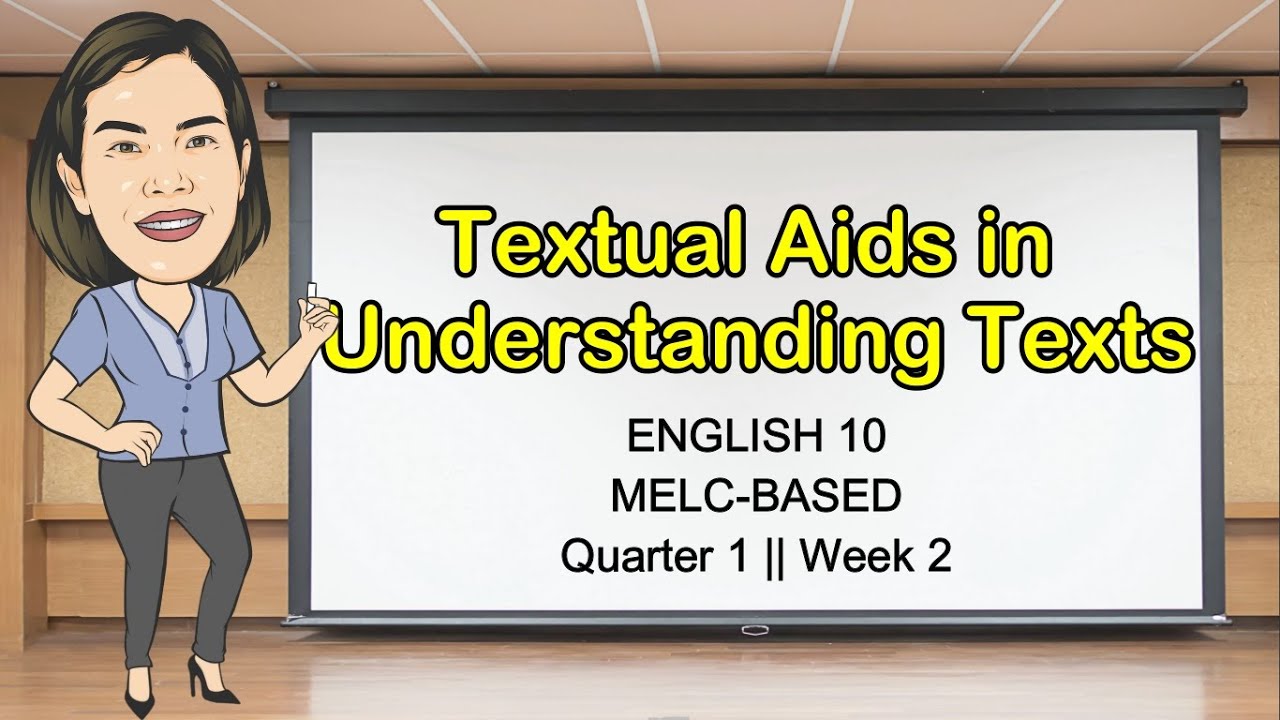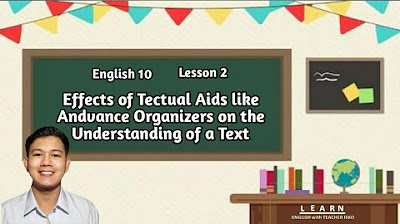TEXTUAL AIDS || GRADE 10 || MELC-based VIDEO LESSON | QUARTER 1 | Module 2
Summary
TLDRThis educational video script delves into the significance of textual aids in enhancing English language comprehension. It introduces advanced organizers, titles, and nonlinear illustrations as tools to guide learners through texts. The script explains various types of advanced organizers, such as expository, narrative, graphic, and problem-solving organizers, emphasizing their role in structuring information visually and preparing students for lessons. It also covers different kinds of nonlinear illustrations, including tables, graphs, and maps, illustrating their utility in simplifying complex data and concepts. The goal is to improve students' understanding and retention of textual content.
Takeaways
- 📚 Textual aids are non-textual elements that assist readers in understanding the content of a text, including titles, subtitles, and various types of illustrations.
- 🔍 Advanced organizers are used by teachers to introduce lessons and guide learners on how to think about the text, including expository, narrative, and graphic organizers.
- 📈 Graphic organizers structure information visually and can take many forms, such as persuasion maps, sequence charts, story maps, and biography graphic organizers.
- 🌐 Titles are important textual aids that improve comprehension and memorability of text by providing a clear overview of the passage's content.
- 📊 Nonlinear illustrations, such as tables, graphs, and charts, are used to represent data and information in a visual format that enhances understanding.
- 📈 Bar graphs represent data with vertical or horizontal bars, where the height of the bar indicates the value it represents.
- 📉 Line graphs are used to show changes in numerical data over time and are ideal for illustrating trends.
- 🍰 Pie charts display how a whole is divided into parts, with each slice representing a percentage of the total.
- 🏷 Pictographs use images or symbols to represent data, making them a simple way to show the frequency of data items.
- 🗺 Maps are textual aids that visually represent selected characteristics of a place, with physical maps showing natural features and political maps showing administrative regions.
- 📝 Analogies, as advanced organizers, help students relate new topics to something familiar, enhancing understanding and retention of information.
Q & A
What are textual aids and why are they important for understanding a text?
-Textual aids are non-textual elements that assist readers in understanding the content of a text. They include titles, subtitles, bold, italicized, and underlined texts, as well as illustrations, maps, tables, graphs, and charts. They are important because they direct the reader's attention to key ideas and provide supplementary information.
What is an advanced organizer and how does it help in learning?
-An advanced organizer is a teaching strategy used to introduce a lesson and guide learners on how to think about the material. It provides a broad idea of the lesson's purpose before it begins and helps students to relate new information to what they already know, thus improving comprehension and retention.
Can you give an example of an expository advanced organizer?
-An example of an expository advanced organizer is when a teacher tells students the lesson's goals at the beginning of the class, such as explaining what habitats are and why animals prefer different living spaces, setting the stage for learning about the layers of a tropical rainforest.
What is a narrative advanced organizer and how does it differ from an expository one?
-A narrative advanced organizer involves storytelling at the beginning of a class to relate to important concepts. Unlike expository organizers that provide a broad idea of the lesson's purpose, narrative organizers engage students through an interesting story that connects to the lesson, such as a tale about a tree frog climbing in a rainforest.
What is a KWL chart and how does it function as an advanced organizer?
-A KWL chart is a three-column table used to organize what students know, what they want to know, and what they have learned about a topic. It serves as an advanced organizer by prompting students to think about their prior knowledge, their curiosity, and their new learning, thus enhancing their engagement and understanding.
How do titles contribute to the comprehension and memorability of a text?
-Titles provide a clear overview of the text's content, improving comprehension by signaling the main idea or focus. Research indicates that passages with titles are better recalled than those without, as titles facilitate later stages of processing and help in organizing information.
What is a graphic organizer and how does it assist in learning?
-A graphic organizer is a visual tool that structures information in pictures or diagrams, often used to outline and prepare arguments, visualize processes or events, or identify elements in a story. It helps students to scheme and organize information, improving their understanding and retention of the material.
Can you explain the function of a sequence chart in learning?
-A sequence chart is a graphic organizer that helps visualize the order of steps in a process or a timeline of events. It is useful for note-taking, lesson planning, and essay writing, as it allows students to understand and remember the sequence of information more effectively.
What is the purpose of a mind map and how does it aid in brainstorming?
-A mind map is a tool that captures the free flow of thought and is used for brainstorming around topics. It helps in organizing and grouping information, allowing for a more structured approach to generating and exploring ideas.
How do pictographs represent data and what are their advantages?
-Pictographs, also known as pictograms, represent data using images, icons, or symbols to indicate the frequency of occurrences. They are advantageous because they provide a simple and visually engaging way to understand data, making it easier for viewers to quickly grasp the information presented.
What is the role of a map as a textual aid in learning about geographical or historical contexts?
-A map, as a textual aid, visually represents selected characteristics of a place, such as physical features in a physical map or political divisions in a political map. It helps learners to better understand and remember geographical or historical contexts by providing a visual framework for the information.
Outlines

このセクションは有料ユーザー限定です。 アクセスするには、アップグレードをお願いします。
今すぐアップグレードMindmap

このセクションは有料ユーザー限定です。 アクセスするには、アップグレードをお願いします。
今すぐアップグレードKeywords

このセクションは有料ユーザー限定です。 アクセスするには、アップグレードをお願いします。
今すぐアップグレードHighlights

このセクションは有料ユーザー限定です。 アクセスするには、アップグレードをお願いします。
今すぐアップグレードTranscripts

このセクションは有料ユーザー限定です。 アクセスするには、アップグレードをお願いします。
今すぐアップグレード関連動画をさらに表示

TEXTUAL AIDS || Grade10|| MELC-based VIDEO LESSON | QUARTER 1| MODULE 2

English 10 | Quarter 1 | Week 2 Textual Aids in Understanding Text

TEXTUAL AIDS IN UNDERSTANDING TEXTS || Quarter 1 Week 2 || English 10 || MELC-BASED || Aizie Dumuk

Grade 10 English Q1 Ep4: Textual Aids

Textual Aids - English 10 - Lesson 2

Kuliah #DIRUMAHAJA - MKWU BAHASA INDONESIA - HAKIKAT BAHASA
5.0 / 5 (0 votes)
